28 September 2018
CHAPTER 10
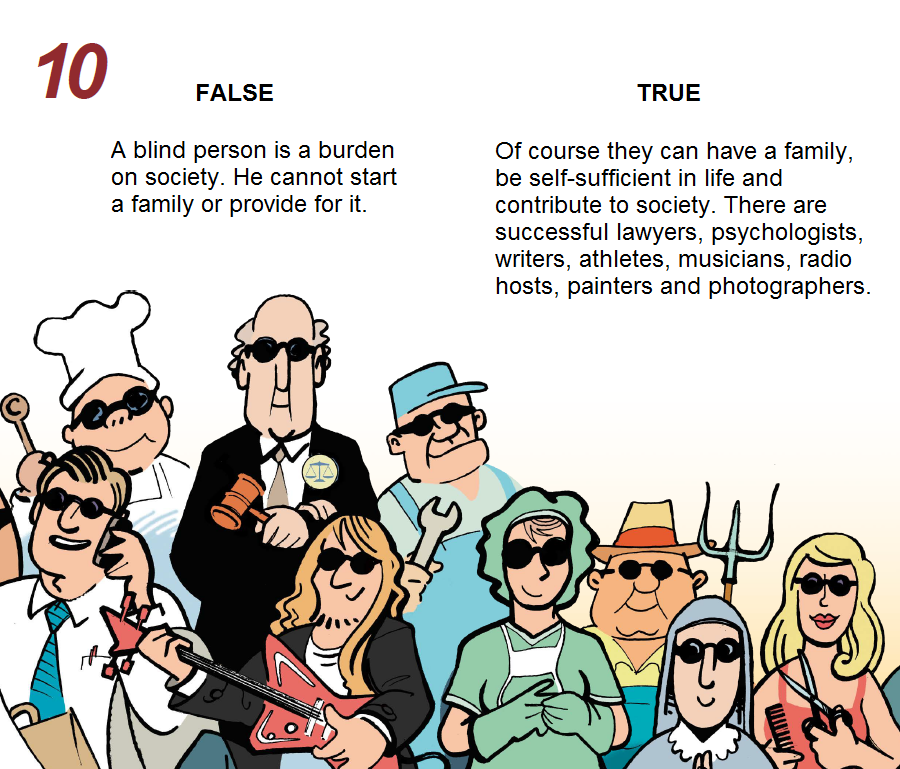 Picture: In the picture is a happy group of people, all wearing sunglasses. They all have different jobs. There is a cook, an entrepreneur, musician, hairdresser, judge, mechanic, nurse, nun and a farmer. The cook is wearing a chef’s hat while holding a spoon, the judge is holding a hammer, the mechanic is holding a wrench. The musician has a guitar, the entrepreneur a telephone, the nurse her work clothes and a protective mask. The farmer is holding a pitchfork, the nun is praying and the hairdresser is holding scissors and a comb.
Picture: In the picture is a happy group of people, all wearing sunglasses. They all have different jobs. There is a cook, an entrepreneur, musician, hairdresser, judge, mechanic, nurse, nun and a farmer. The cook is wearing a chef’s hat while holding a spoon, the judge is holding a hammer, the mechanic is holding a wrench. The musician has a guitar, the entrepreneur a telephone, the nurse her work clothes and a protective mask. The farmer is holding a pitchfork, the nun is praying and the hairdresser is holding scissors and a comb.
FALSE
A blind person is a burden on society. He cannot start a family or provide for it.
TRUE
Of course they can have a family, be self-sufficient in life and contribute to society. There are successful lawyers, psychologists, writers, athletes, musicians, radio hosts, painters and photographers.
CHAPTER 9
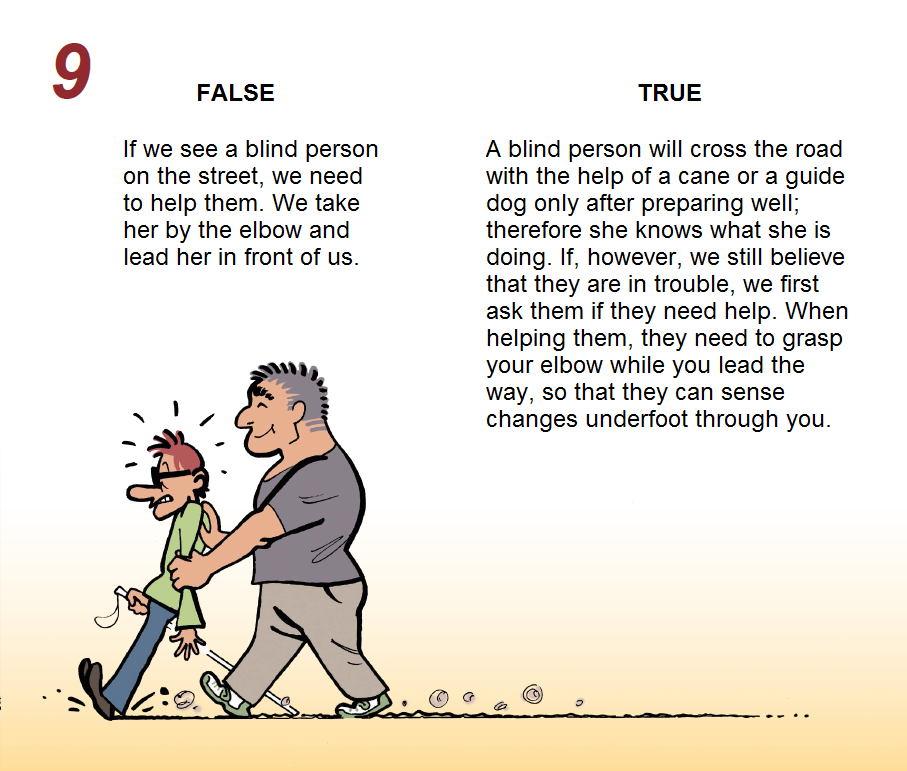 Picture: A happy sighted person, who is tall and physically strong, is pushing a physically weak blind person in front of them. The blind man has a cane in his right hand and is wearing sunglasses. He is not enjoying the experience and is trying to break free.
Picture: A happy sighted person, who is tall and physically strong, is pushing a physically weak blind person in front of them. The blind man has a cane in his right hand and is wearing sunglasses. He is not enjoying the experience and is trying to break free.
FALSE
If we see a blind person on the street, we need to help them. We take her by the elbow and lead her in front of us.
TRUE
A blind person will cross the road with the help of a cane or a guide dog only after preparing well; therefore she knows what she is doing. If, however, we still believe that they are in trouble, we first ask them if they need help. When helping them, they need to grasp your elbow while you lead the way, so that they can sense changes underfoot through you.
CHAPTER 8
Picture: A blind person with a white cane and his dog are sitting in a car. The dog is driving the car. He is wearing a hat and a driver’s uniform. The blind man is sitting in the back, enjoying himself.
FALSE
A guide dog can bring a blind person wherever he or she wants. He even warns them when the light at a crossing turns green.
TRUE
The blind person needs to know the way. A guide dog is taught to recognize obstacles, obey the orders if its owner and to help her get to her destination as safely as possible. At a road crossing, the person needs to be listening to voice cues and traffic flow. We should not pet the dog or make eye contact with him when he is on the job.
CHAPTER 7
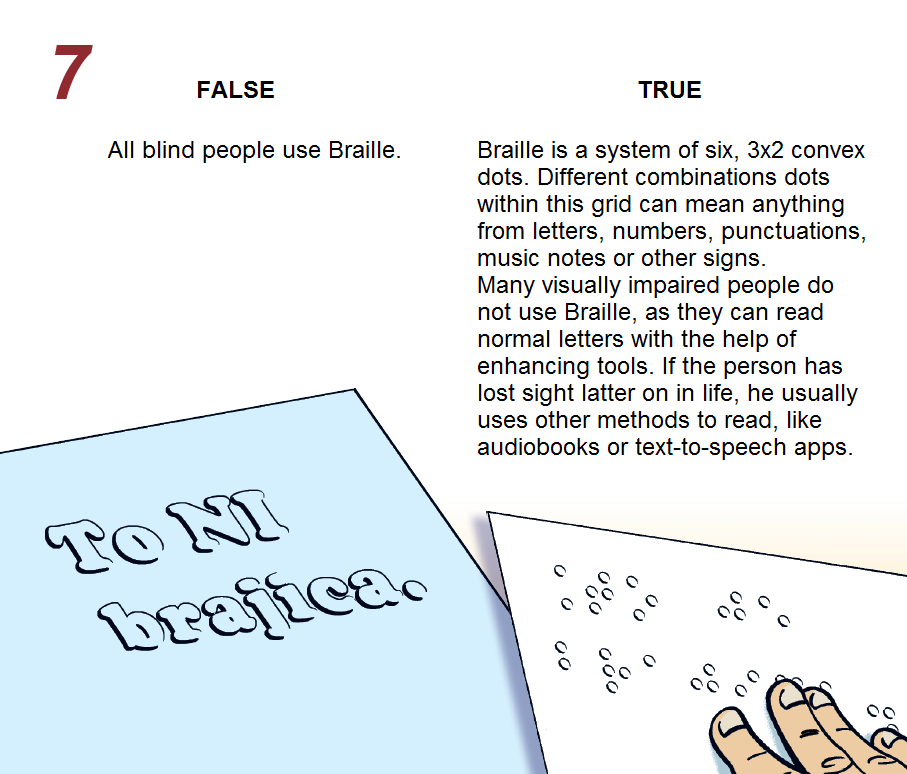
Picture: There are two sheets of paper in the picture. One has “This is not
Braille” in a normal alphabet written on it, the other contains Braille writing. You can see the fingers of someone touching this paper.
FALSE
All blind people use Braille.
TRUE
Braille is a system of six, 3x2 convex dots. Different combinations dots within this grid can mean anything from letters, numbers, punctuations, music notes or other signs. Many visually impaired people do not use Braille, as they can read normal letters with the help of enhancing tools. If the person has lost sight latter on in life, he usually uses other methods to read, like audiobooks or text-to-speech apps.
CHAPTER 6
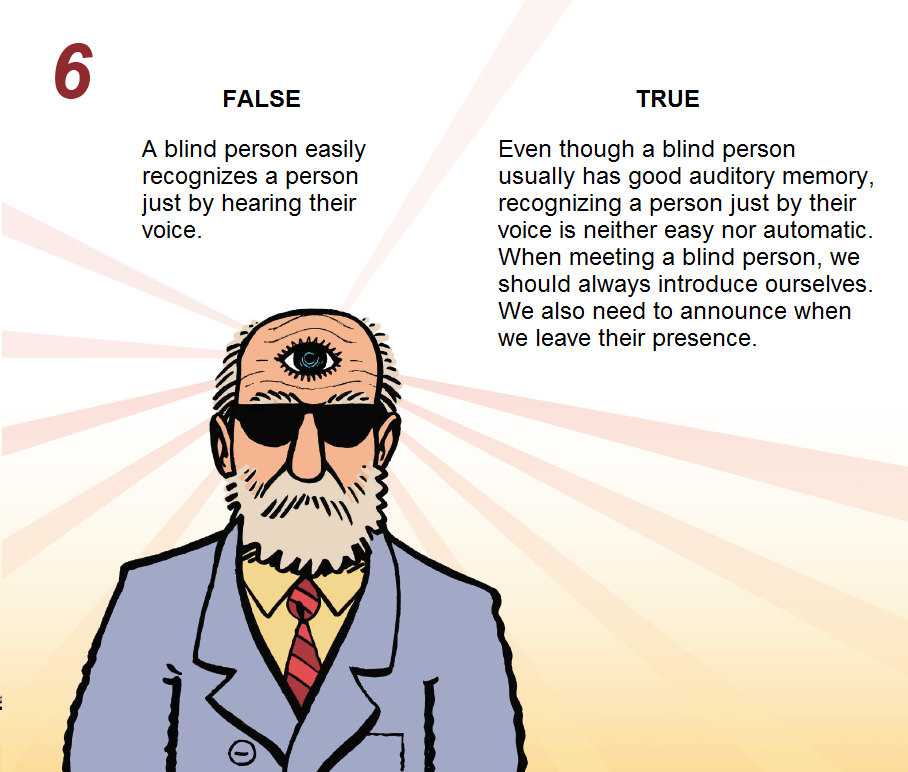
Picture: In the picture is an older, bearded man with a mustache. He has almost no hair and is wearing dark glasses. In the middle of his wrinkled forehead is a large, with which he sees.
FALSE
A blind person easily recognizes a person just by hearing their voice.
TRUE
Even though a blind person usually has good auditory memory, recognizing a person just by their voice is neither easy nor automatic. When meeting a blind person, we should always introduce ourselves. We also need to announce when we leave their presence.
CHAPTER 5
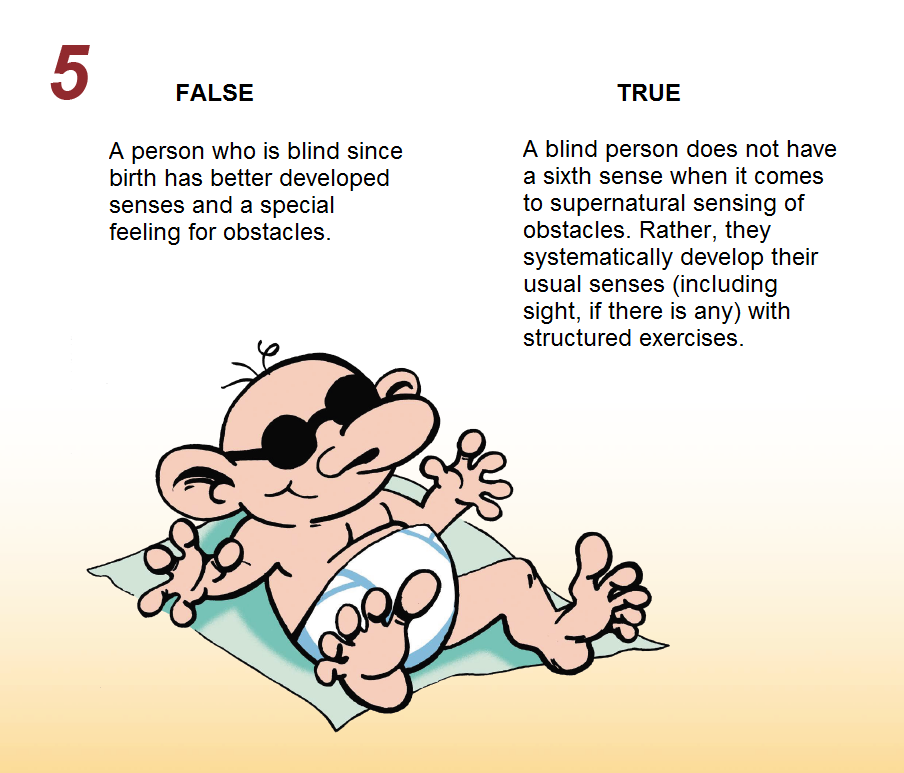
Picture: A baby with a grownup face and a large nose is lying on a towel. He is wearing sunglasses and a diaper. His hands are clasped and he is smiling.
FALSE
A person who is blind since birth has better developed senses and a special feeling for obstacles.
TRUE
A blind person does not have a sixth sense when it comes to supernatural sensing of obstacles. Rather, they systematically develop their usual senses (including sight, if there is any) with structured exercises.
CHAPTER 4
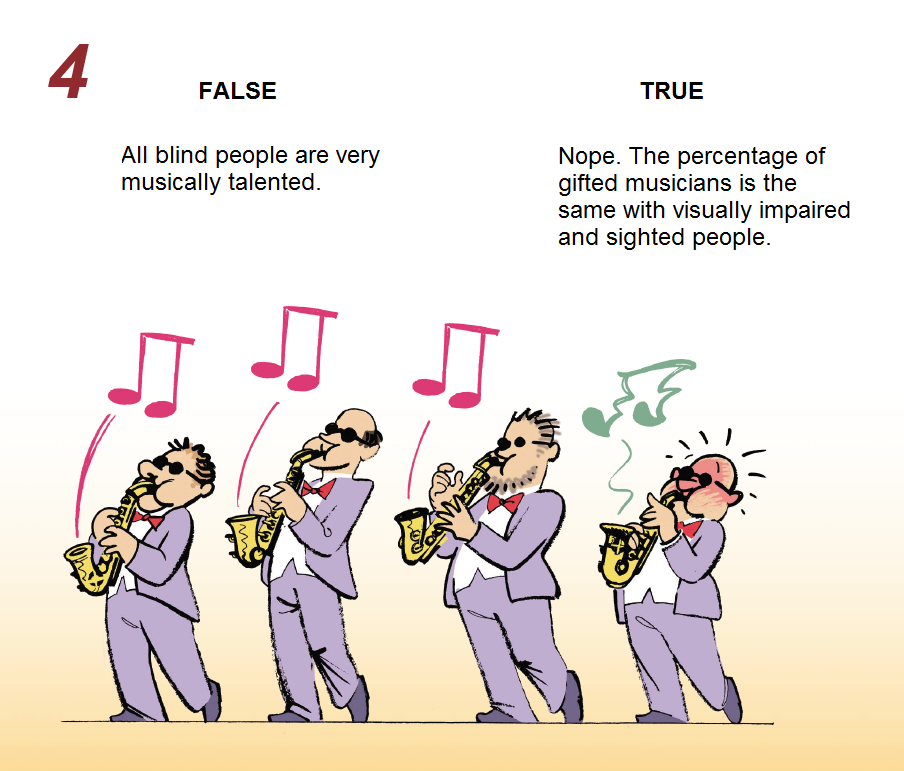
Picture: Four men in tuxedos bowties and sunglasses are playing their saxophones. They are middle-aged, two being bald and one sporting a beard. Three of them know how to play; one has no idea what he is doing.
FALSE
All blind people are very musically talented.
TRUE
Nope. The percentage of gifted musicians is the same with visually impaired and sighted people.
CHAPTER 3
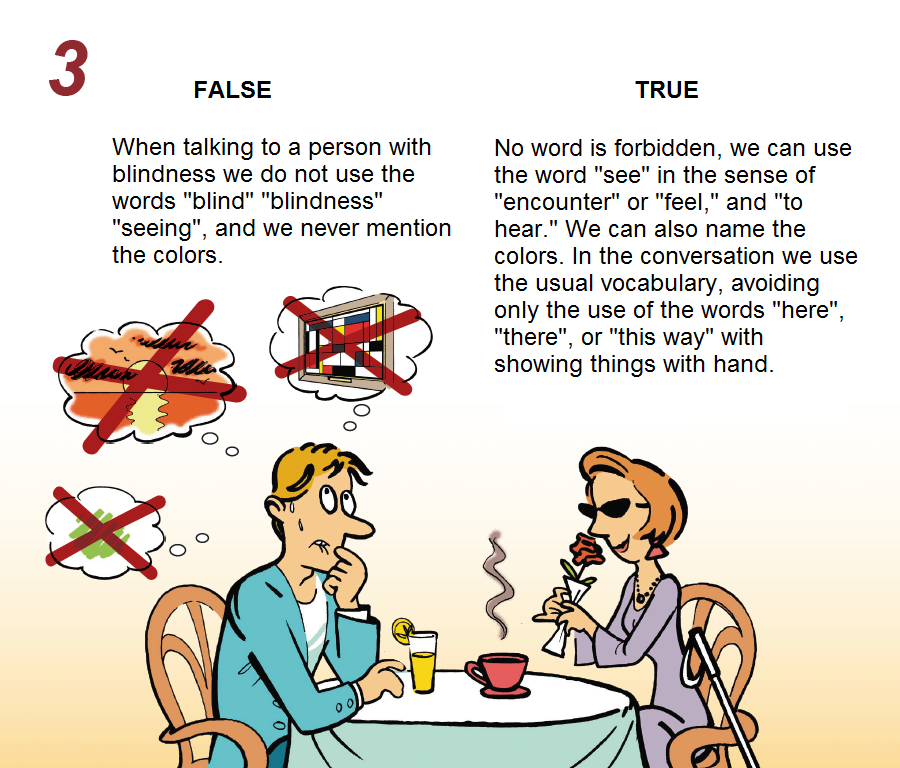 picture: A man and a woman sit a table. The woman is holding a rose in her hands. The woman is blind. She is smelling the rose with a smile on her face, while the man is thinking which words he cannot use.
picture: A man and a woman sit a table. The woman is holding a rose in her hands. The woman is blind. She is smelling the rose with a smile on her face, while the man is thinking which words he cannot use.
FALSE
When talking to a person with blindness we do not use the words "blind" "blindness" "seeing", and we never mention the colors.
TRUE
No word is forbidden, we can use the word "see" in the sense of "encounter" or "feel," and "to hear." We can also name the colors. In the conversation we use the usual vocabulary, avoiding only the use of the words "here", "there", or "this way" with showing things with hand.
CHAPTER 2
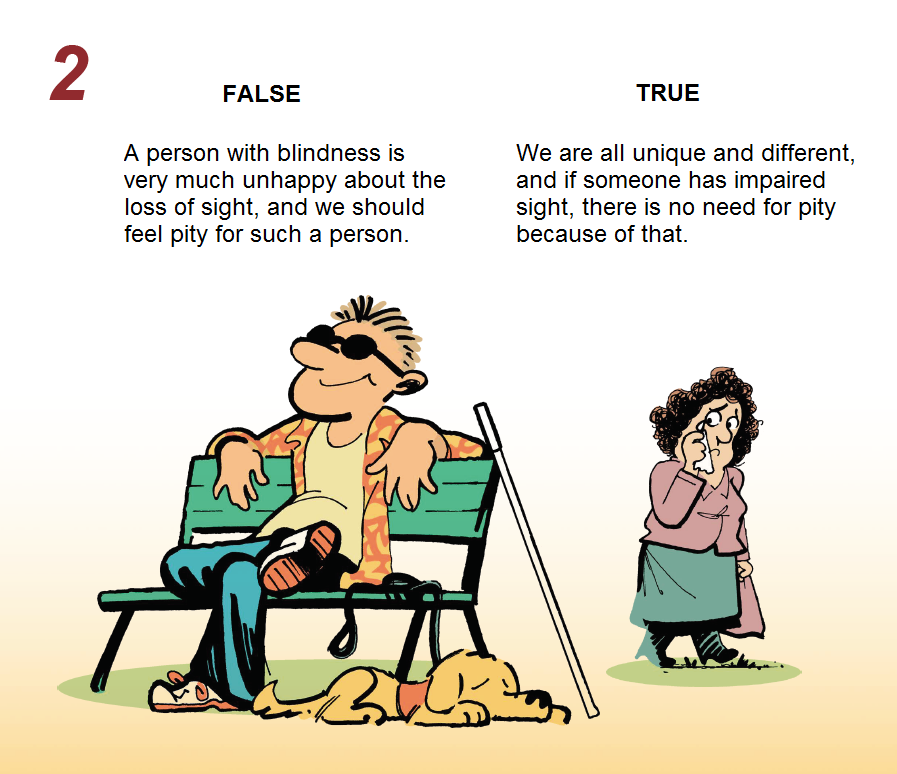 picture: A happy blind man with black sunglasses sitting on a bench, a sleeping guide dog at his feet. His walking stick is set beside him. An older lady is standing behind him, wiping away tears from her face with a handkerchief, a sad look in her eye. It is obvious that she pities him.
picture: A happy blind man with black sunglasses sitting on a bench, a sleeping guide dog at his feet. His walking stick is set beside him. An older lady is standing behind him, wiping away tears from her face with a handkerchief, a sad look in her eye. It is obvious that she pities him.
FALSE
A person with blindness is very much unhappy about the loss of sight, and we should feel pity for such a person.
TRUE
We are all unique and different, and if someone has impaired sight, there is no need for pity because of that.
CHAPTER 1
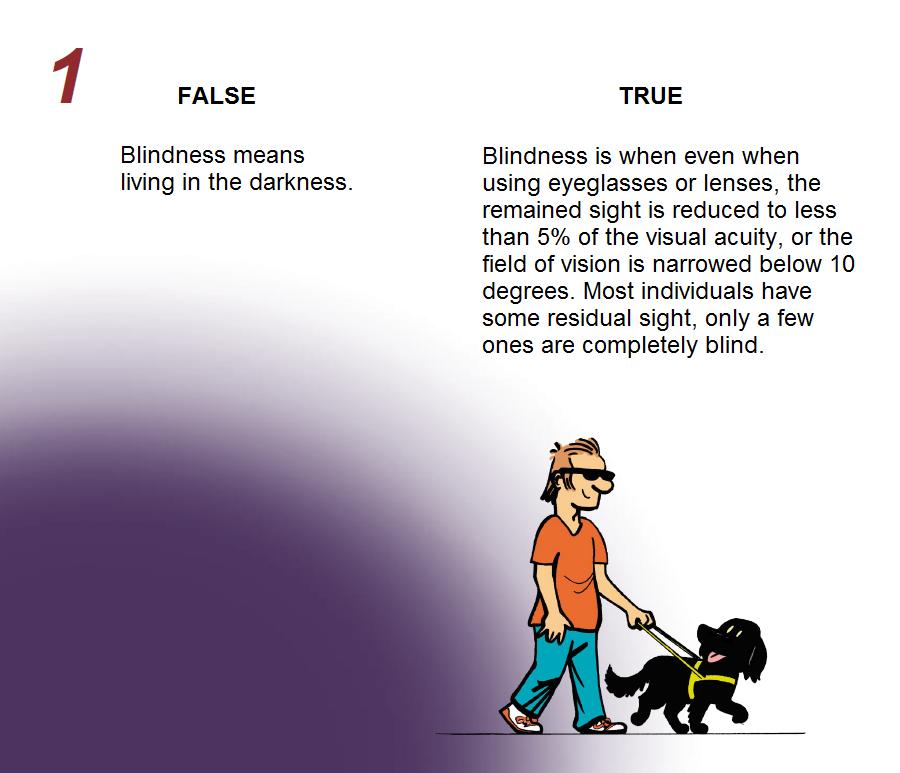 picture: A happy blind man with black sunglasses walking with the help of a guide dog, who is happily turning around to him.
picture: A happy blind man with black sunglasses walking with the help of a guide dog, who is happily turning around to him.
FALSE
Blindness means living in the darkness.
TRUE
Blindness is when even when using eyeglasses or lenses, the remained sight is reduced to less than 5% of the visual acuity, or the field of vision is narrowed below 10 degrees. Most individuals have some residual sight, only a few ones are completely blind.
Authors of the text: Ingrid Žolgar in Aksinja Kermauner, Illustrated by Gašper Rus
Other participants: Brane But, Sonja Pungertnik, Mateja Jerina Gubanc, dr. Manca Tekavčič Pompe, Aleksandra Surla (dog guide), Marinka Vičič, Diopta d.o.o., Abanka, Institut Integra, Printing house Povše in Alpa papir and Association of Friends of the Blind of Slovenia